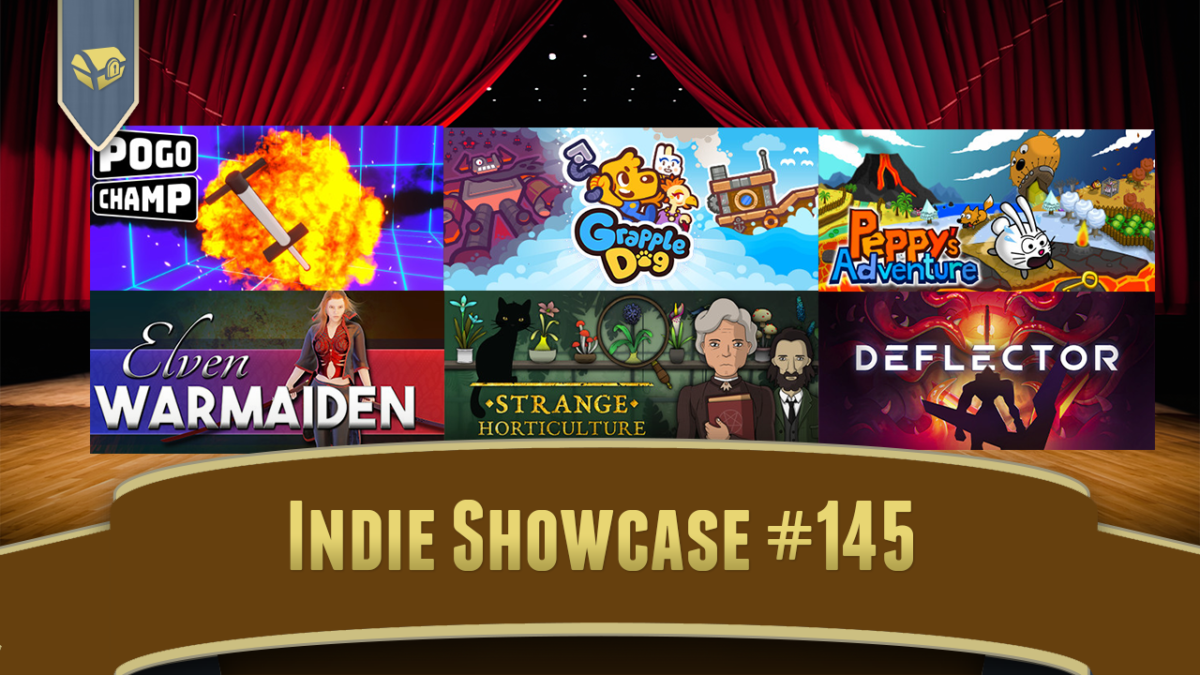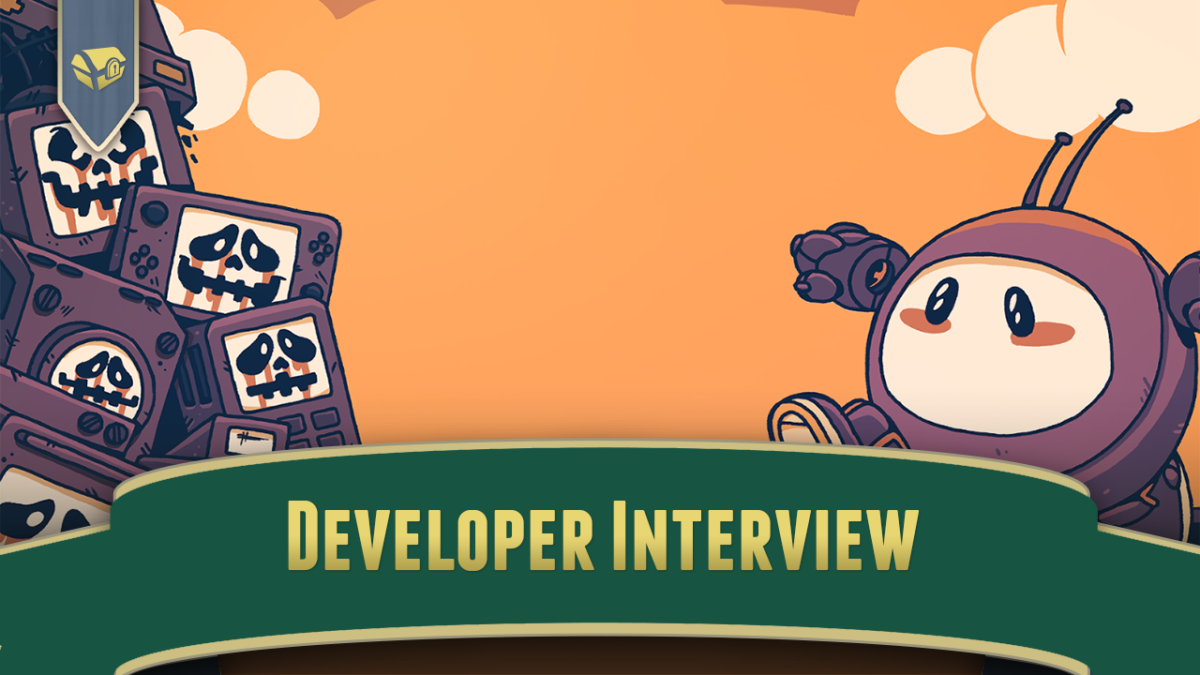Blaseball returns January 9th!
Year: 2022
Sundry Sunday: “Everything You Need To Know” About Five Nights At Freddy’s
Oy. There are few lorebombs of niche gaming more intricate, and as utterly impenetrable to the uninitiated, as the Five Nights At Freddy’s superseries. What started mostly as a jumpscare delivery mechanism turned out to have backstory, and sequels, and prequels, and novels, and side games, and more.
The “Everything You Need To Know” series takes properties with sizable amounts of lore and tries to condense them to make them generally understandable. By no means do they cover all of the details, choosing to get the gist across simply rather than to explain everything that’s going on. It’s a bit humorous, but the point here isn’t a comedy and/or snarky retelling, as with the So This Is Basically series, but to give you a good rundown with some leavening humor along the way.
So, what will you do with your newfound knowledge? Impress kids? Write fanfiction? Perform exorcisms? Seek to create knockoffs?
Roguelike Celebration: Adam Newgas on Constraint-Based Generation
Honestly, I could devote a post to every Roguelike Celebration talk. I’ve been limiting myself to just one such post a week, on Saturdays. This one, a short sixteen minutes talk about terrain generation, is for the developers out there.
Constraint-based generation, also known as “wave function collapse,” is a system where, as objects are placed randomly during generation, the generator “solves” the world around them, placing later terrain as is necessitated by prior terrain. If the generator reaches a contradiction, a situation where there is no viable terrain that can be placed, it undoes the contradictory placement and continues from there.
It’s a technique that’s fairly popular in procedural generation circles, and among other games is used in Caves of Qud. It’s also fun to watch it work!
Getting Started in Odd Giants
We mentioned Glitch remake project Odd Giants back in October. It’s incomplete, and the game it seeks to revive was incomplete too, so there’s a lot missing. Still, Glitch (not that Glitch) was beloved among a certain faction of internet people, and some of that magic is still there.
It’s an unusually chill thing to play. To get a sense of the game, here is a promotional Youtube video from 2011, which looks a little different from how the game evolved, but conveys Glitch’s great sense of whimsy:
Now, there are lots of forgotten, abandoned, or failed games that are worthy of a second look, or would be if anyone knew of them. They are an invisible ocean around us, most games that have been made, by far, will disappear unknown and unloved. While many of them perhaps aren’t worth knowing about, some of them definitely are. Just because Stewart Butterfield backed this one doesn’t mean it was any good. But, some people liked it, and remember it fondly, and I’m one of them. We like old and forgotten pastimes here at Set Side B, and want to tell as many people about them as we can, as long as we are able.
Glitch was a Flash-based web MMORPG platformer. You played as a glitch, plural glitchen, a humanoid creature living in the land of Ur, which existed within the thoughts of eleven godlike Giants. (Eleven is kind of a sacred number in Glitch and Ur.)
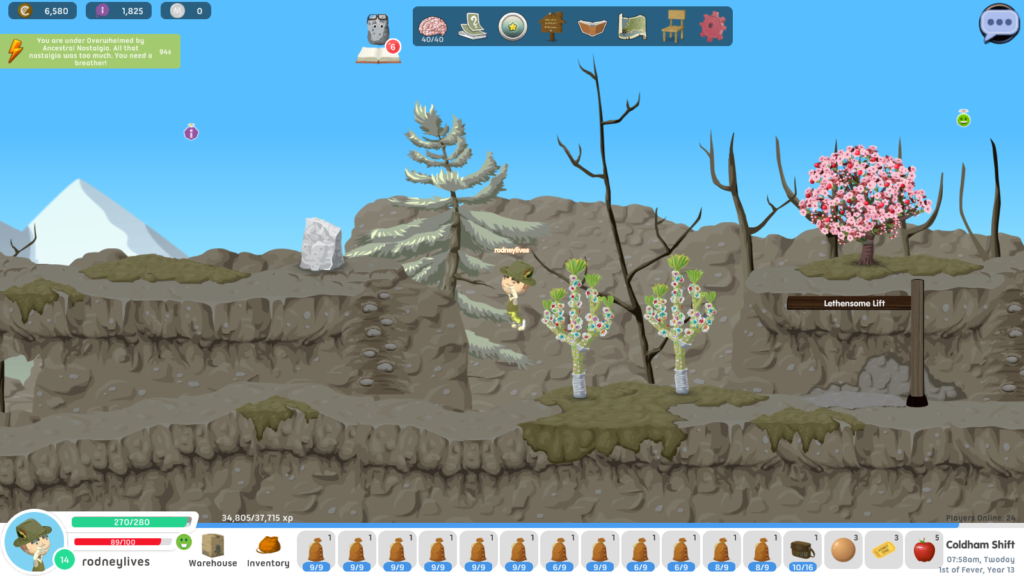
Glitch was created in Flash, and it was already in the outs back then, preventing iOS players from entering. Since Flash is unusable in browsers any more (without alternate runtimes like Ruffle), Odd Giants is implemented in Unity, which means you can’t just jump into the game by browsing to a site, and that you have to download a 1.2 gigabyte client to play. And you’ll have to download a new one when there’s a major update. But on the other hand it means all of the game’s graphics are stored on your computer, greatly speeding load and transition times. I think I prefer to play it this way.
As I said, Glitch was created by Stewart Butterfield, the creator of Flickr and, later, Slack. (In fact, Slack’s communication code has its basis in the chat system from Glitch.) In a move atypical of many rich tech bizzes, when Glitch shut down, its production studio Tiny Speck donated nearly all of the game’s assets to the public domain, which is what makes Odd Giants, and other Glitch remake projects like Children of Ur and Eleven, legal. (Tiny Speck renamed themselves to Slack, but it’s the same company. They just make business communications software now instead of a laid back exploratory MMORPG platformer.)
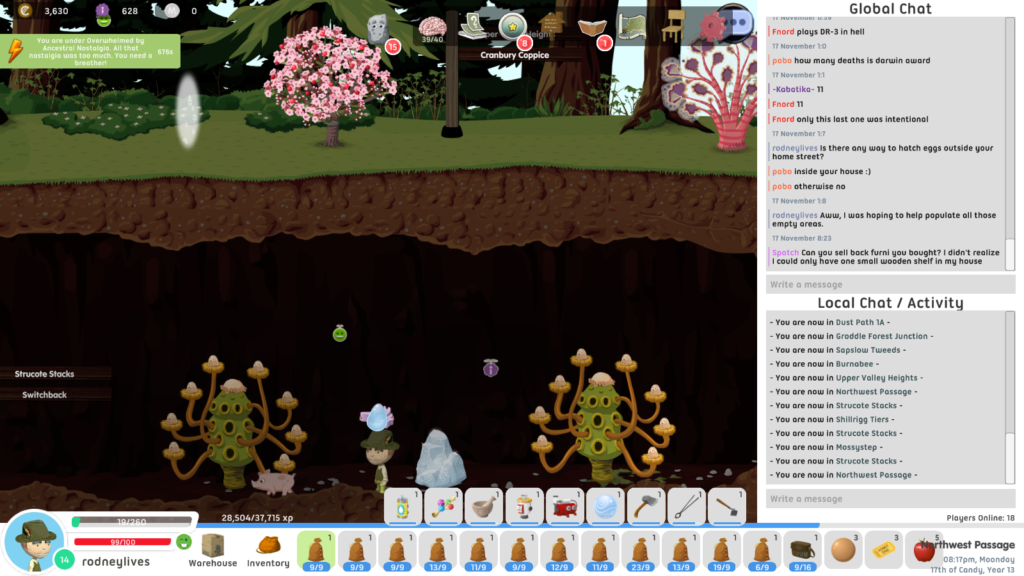
Glitch, and thus its revival/remake Odd Giants, is a platformer, but it eschews many of the basic principles of platformers. There are no enemies, you never die from falling off the screen, and dangers are few. Platforming, running and jumping, is mostly just a way of getting around and collecting “quoins,” little objects floating around the games many areas. If you never lost that basic joy of running Mario around terrain without having to stomp on things or dodge hammers, you’ll have fun in Odd Giants.
Since the world of Ur is in the Giants’ thoughts you don’t actually encounter them directly as creatures in the game, but their presence is felt in many ways. Particularly, there are shrines to them all over, where you can donate objects for their favor, and eventually earn Emblems and Icons devoted to them.
The world of Ur is divided into a number of regions, each divided into a hash of streets, which are shown on the region map as lines. Here’s a map of Groddle Forest, the starting area:
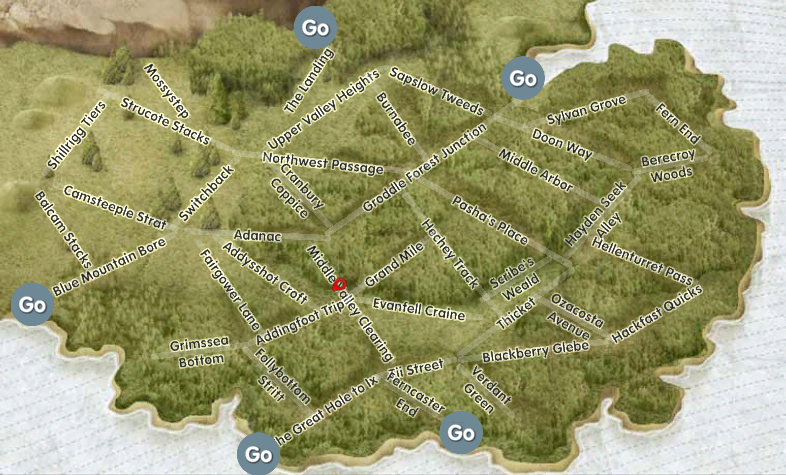
Each street’s left-right scroll corresponds to its in-game area. If you’re standing at the left edge of a street in the game, you’ll also be at its left edge on the map. Where the streets connect on the map, there are signposts in the game that allow you to transfer to connecting streets. It’s not a completely frictionless way of navigating the game’s regions, but it’s easy to get used to.
If there are no enemies, then what do you do in Ur? Mostly you just run around and collect Quoins, and also water trees, harvest fruit, mine rocks, squeeze chickens, milk butterflies, nibble on piggies, and other miscellaneous activities. These actions are initiated by clicking on an object and selecting the action from a menu. When you do, a progress meter appears, which fills quickly. Most actions just take two or three seconds. As you advance, you become able to more things like make meals or transmute metals, that build off of the things you did at the start.
There is no solid final goal. It’s just a world to explore and have fun in. Without enemies to fight, some people will find this pointless. That’s okay. It was always something that some people would find unappealing. But if you like the idea of a non-violent game where you can talk with friends and do silly things in, then you may enjoy playing Odd Giants.
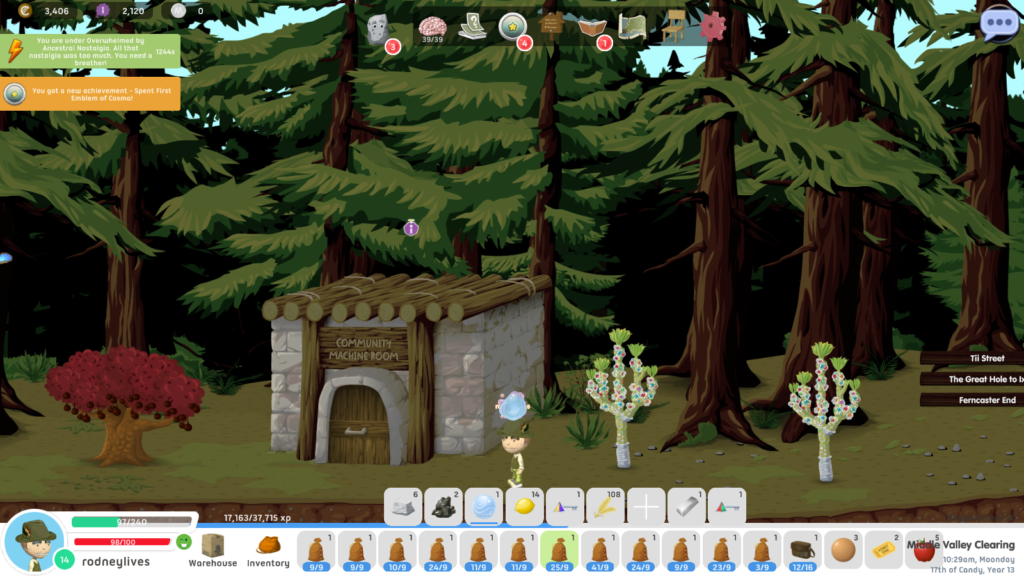
Aiding in this is a great sense of whimsy and fun that suffuses almost everything aspect of the play. The graphics are charming throughout, with well-animated creatures and many scenic vistas to explore. Almost every text sentence in the game has a joke or two in it. Just playing to see whatever funny thing to see or read next can be entertaining, for a little while at least. The music, especially, is worth checking the game out for a little while. I don’t think I’ve heard a single track that isn’t great.
As you do things, you use up your Glitch’s Energy. If you run out of energy, your little person “croaks” and ends up in Hell! But Hell is a region of streets, just like the others. It’s not hard to get out of Hell. You just run around squishing grapes lying on the ground. Squash enough and you’ll be returned right where you were, although without much energy. You could even spend a Get Out Of Hell Free card, if you’ve found one, and bypass that whole process. A lot of the negative things in Glitch/Odd Giants are pretty light like this. No punishment ever really feels punishing, although it may interrupt what you were doing for a bit.
In addition to Energy, glitches have Mood, which slowly depletes and decreases rewards if it dips too low, and “iMG,” or Imagination, a general advancement currency used to pay for Upgrades and other features, like expanding your house. There’s also experience points, or “XP,” which contributes to a glitch’s experience Level, but Level doesn’t affect the game much at all. It just seems to gate being able to use a few high-end items that you probably won’t even see for a while.
Instead of level, most of your character’s advancement comes from buying Upgrades and learning Skills. Some Upgrades are things like being able to walk faster and getting a triple jump, but most are things like increasing your maximum Energy, increasing the bonuses you get for Quoins, or getting bonus items randomly while doing things, or other things of that nature. Upgrades are bought with iMG, and are offered from a “deck” three at a time. You can buy any that are offered, but to get new options you’ll have to “reshuffle.” This will put the unbought upgrades back into the deck and deal you three new ones. As you buy Upgrades and remove them from play, the deck is seeded with more powerful, and much more expensive, replacements. Every game day (which last for four hours of real time) you’re allowed two free reshuffles, with them growing in price after that. There are also some other special upgrades that can be bought repeatedly, like Get Out Of Hell Free cards, extra Reshuffles, and access to special bonus areas (that, unfortunately, mostly don’t work yet in Odd Giants).
Most Upgrades are nice extras. The need to have Skills, on the other hand, blocks access to more major game features. There’s a complex array of Skills, many requiring other Skills, or particular accomplishments, under your belt before you can learn them in a kind of skill tree. Each skill takes real time to learn, which pass whether you’re in-game or not. Some skills take hours, or even days, to learn.
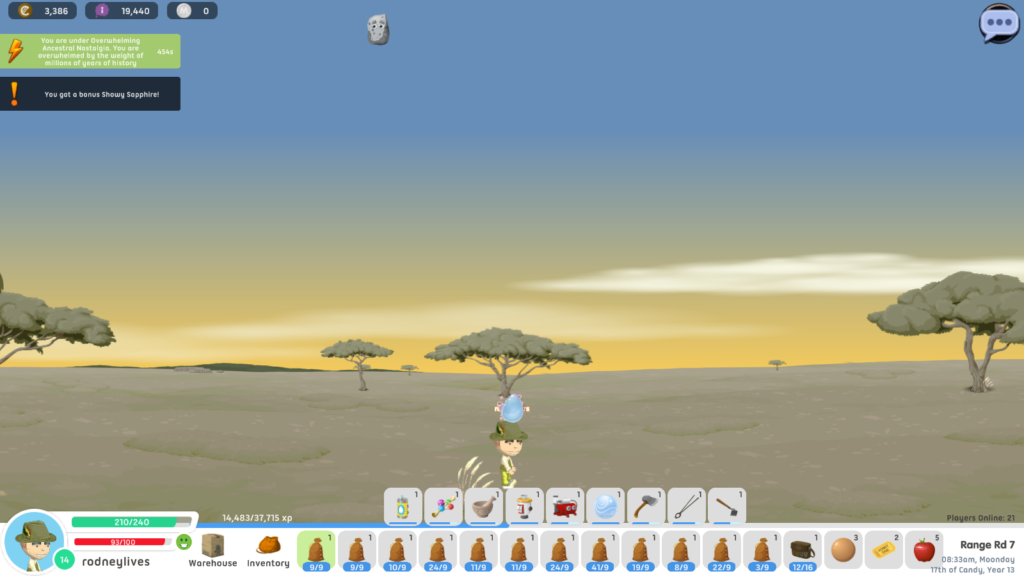
You start out with the capacity to know ten Skills. Back in Glitch, you could still learn skills if you were over capacity, but they took even longer. In Odd Giants, at least for now, your capacity is a hard limit, but you can raise it with Upgrades.
Some Skills are really basic things, like access to the Info command on objects, or access to the map. Most of them give you new powers, like being able to teleport places, or allow you to use items like the Meditation Orb. Many things are blocked until you learn the requisite skill, so it’s good to always make sure you have one learning, if you have excess capacity, when you log off from the game.
It cannot be denied, though, that sometimes the game feels like a gussied-up skeleton of progression systems with a visual veneer. You can make some cool items later on, like “Essence of Purple” or “No-No Powder,” but you’ll have to master many skills to get to that point. Glitch had a number of mini-games to discover that you could play at low levels by finding Game Show Tickets, and bonus levels you could buy at the Upgrade shop, but none of those things work currently. It makes the early going a bit of a slog, but the players in the game tend to be very friendly and helpful, and willing to give new players advanced items just for asking.
Details to get you started
It’s fun to collect quoins, those little floating powerup items that are scattered in many streets, but truthfully they don’t earn you much. Once in a while a quoin will give you a larger-than-usual bonus, but it’s infrequent, and rarely enough to bother going out of your way to collect them. Still, they’re fun to pick up, so I usually do it anyway.
Your Energy cap is a major limiter of your activity. Food items usually restore Energy, so it’s good to stock up on those. Learning the skill Meditation I lets you use a Meditation Orb, which allows you to regenerate a random amount of Energy or Mood when you want, with only a 30 second timeout to using it repeatedly. I would try to get that as soon as possible.
You’ll want to earn lots of iMG to unlock Upgrades and expand your yard and home. Most things you do will earn you at least a tiny bit of iMG. When you get the Skills to use machines to make stuff, you can usually convert several items at once, which can get you more for less work. A lot of your iMG will come from Achievements, which the game tracks in the background for you, and Quests, which are usually randomly assigned.
There is a bug in the current version (0.14.1), as I write this, that allows you to get all the rewards for most Quests without having to do them. Just cancel the Quest from the quest screen, then exit the game and reenter. You’ll have to wait 30 seconds before coming back in, but when you do you’ll get the full reward! One of the Quests, the one that asks you to construct an Icon, is extremely time-consuming to complete, but has high rewards. This can be used to help fund some of the most expensive Upgrades.
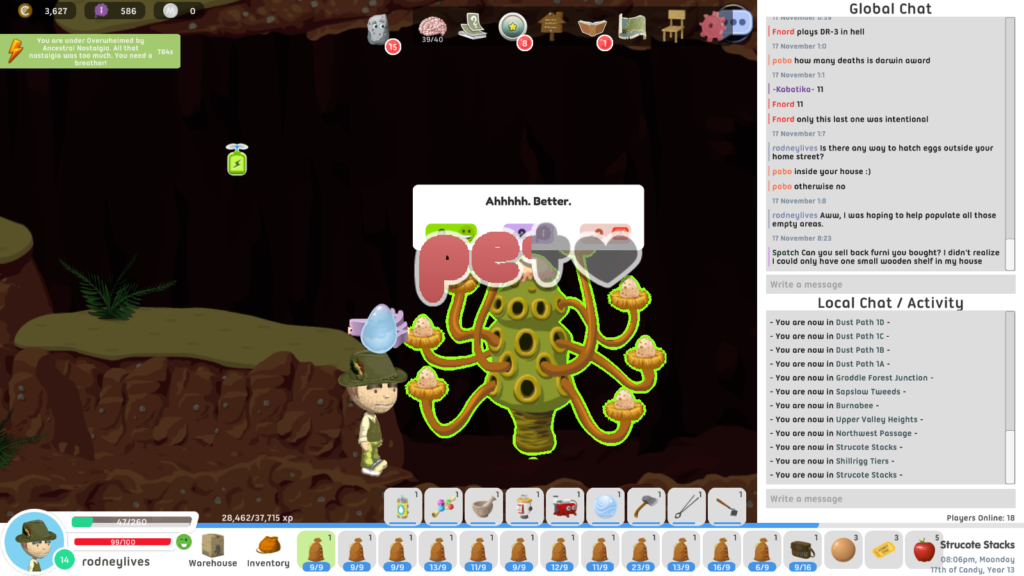
You can gain a lot of iMG every game day by using Emblems and Icons. There are shrines to the 11 Giants around many areas. You can click on one to donate items to it, which awards you an amount of iMG, and well as favor with that Giant, depending on the value (in the game’s money, called Currants) of the item. If you built up 1,000 points of favor with a Giant, you can exchange it for an Emblem for that Giant. (In 0.14.1, the first time you do this with each Giant you’ll receive two Emblems, which is good since you can immediately spend one to unlock an important skill!) Using an Emblem’s Contemplate command can be worth 30 iMG per Emblem of that Giant you’re holding. That takes up a lot of inventory space, so you’ll want to invest in bags, which you can buy from vendors to carry more. It takes a significant number of Currants to outfit yourself with full Bigger Bags, but it’s ultimately worth it because you can carry so many more Emblems, and all kinds of other things too.
If you collect 11 Emblems, you can combine them into an Icon, which can be set on the ground and be Reflected upon, for even more iMG. In the Groddle Heights region, at the moment, there are a number of Icons set up on the ground for people to use, although sometimes they require a small Currant payment. If you can find your way to Xalanga, the region Zealous Rd NE currently has all 11 kinds of Icons set up for easy use.
Some features are not yet coded. Some of these are in the game as Upgrades or Skills that don’t work once acquired. There is no indication which these are, which sucks, but what can I say the game’s under heavy development. One of these as of this writing are the ability to unlearn skills to make room for others, and most of the bonus levels you can buy as Upgrade cards.
At the moment lots of areas have terrain but not much of interest to find in them. Many of the special areas don’t yet work. One that does, at least, are the Savannah areas, among them Choru, Xalanga, Zhambu, Baqala, and some others. Try navigating there if you want to find a lot of valuable items quickly.
There are some other things to do if you explore a bit, but many things that were in Glitch are not yet implemented. It’s a bit wild and woolly in that regard, but presumably that kind of stuff will be implemented eventually. As it is, it’s still fun to log in, customize your character (click on their portrait in the bottom-left corner of the window), and run around and explore.
More information
An archived version of the wiki for Glitch is here. There’s also a lot of information left up at the game’s website.
While constructing this post I rummaged through the Metafilter archives (which are a great resource) and found a number of related posts:
On Game Neverending (a predecessor of Glitch). On how it gave rise to Flickr. On Glitch itself. On Katamari Damacy creator Keita Takahashi joining up with Tiny Speck. On Glitch’s closing. On Keita Takahashi’s idea journal. On the grant of Glitch’s assets to the public domain. On the Glitch Forever wiki revival.
News 12/1/22: DABLOONS

“We scour the Earth web for indie, retro, and niche gaming news so you don’t have to, drebnar!” – your faithful reporter
Quite a bit to get through today! Pull up a florb and moop for a bit!
Luke Plunkett at Kotaku informs us of Nintendo pulling support from the third-party tournament Smash World Tour, leaving them in a gigantic financial hole. This will severely harm tournaments’ willingness to trust Nintendo in the future, and the esports scene around future Nintendo products. Nintendo’s response at the end is especially frustrating, claiming they did not request any events be cancelled while still denying SWT a license, forcing them to cancel anyway.
Benj Edwards at Ars Technica: an AI from Nvidia can play Minecraft now, performing tasks based on text prompts. Congrats, you’ve invented a 10-year-old!

After our initial post, I’ve purposely been trying not to talk up the Super Mario Bros. movie, but I do think this post from Ryan Leson at IGN is of interest, about Shigeru Miyamoto noting that Donkey Kong’s been a bit redesigned for the movie, still recognizably the Rare-made version of the character, but with some adjustments to more resemble the original version.
Here’s Rich Stanton at PC Gamer on the effort to preserve a Ridge Racer Full Scale, a version of the arcade game that featured an actual car chassis the player would sit it, had triple ultra-wide display, and cost operators $250,000. Very few were sold, and it’s possible only one survives, which was in Blackpool. After an arcade museum sought to purchase it, but refused when they learned of damage to the frame, it was thought lost, but although the physical structure of the unit has not been salvageable, the car portion and the hardware have been saved, and its code dumped. More can be read at Arcade Blogger.
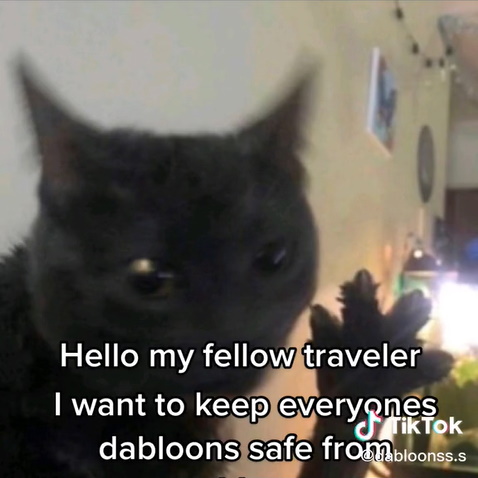
Richael Watts at Rock Paper Shotgun has a piece up on Dabloontok, an RPG-ish thing a bunch of people are doing on TikTok, involving cat videos trading an imaginary currency called “dabloons.” This isn’t imaginary in the sense of crptocurrency, or indeed all money when you think about it; this is really imaginary. How many you have is completely on the honor system. Participants use it to “trade” with these cats, and they can also be “stolen” by them. The whole thing seems pretty silly overall, but it’s entertaining to learn about!
And at Engadget, I. Bonifacic remarks upon Pong turning 50 years old. Yeah, that number isn’t getting any smaller. It’s a useful retrospective, although I take issue with them saying that without Pong Nintendo would not exist. Nintendo is over a century old, originally making playing cards. What is more likely is they wouldn’t exist as we know them today-they may not have gotten into video games at all. (By the way, they make traditional Japanese game playing equipment too, like go boards!)
Romhack Thursday: Astro Smash ‘N’ Blast!

On Romhack Thursdays, we bring you interesting finds from the world of game modifications.
Most of the things we post here are game hacks. That is, something that has been modified from a published game. Hacking games is not illegal, but the process that some people usually use to obtain the roms themselves may be somewhat questionable. Well not for the subject of this week’s article: it’s 100% homebrew, created from scratch and unencumbered by such considerations! It runs on NES hardware (or an NES emulator), but technically speaking what we have here is more of an indie game on classic console hardware more than a hack.
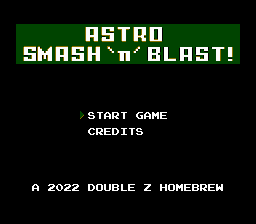
It’s also an unusual subject for a 2022 indie game. You’ll find all kinds of hacks to, say, put silly characters into Super Mario Bros., but a remake of an Intellivision game, and one with an Atari port that is very much its equal, and porting those games to the NES-that’s unusual enough to merit discussion, even if the game itself is very simple.
Astrosmash! (with the exclamation point) was a very popular game for the Intellivision. I heard it was originally intended to be an Asteroids-style game, with rocks that split into pieces when shot, but turned out to be interesting translated to a Space Invaders-style missile base game, where your ship is stuck to the bottom of the screen shooting at targets falling from above. Astroblast! was released by M-Network (Mattel’s label for publishing games for competing systems), and was a very similar game for the Atari VCS/2600, but actually improved on the original in two ways: it can be played with either the joystick or paddle controller. It’s the only game for the VCS like that! Both control schemes are fun, although experts can probably play much better with the paddle, due to both its faster and more precise movement. And, it’s extremely fast! The sheer pace of the VCS Astroblast is so much greater than the Intellivision Astrosmash that it kind of demonstrates why VCS games tend to be more engaging than Intellivision games: it wastes no time with an easy ramp up in difficulty, but starts faster than almost any other game, and only gets harder from there. It’s simply exhilarating!
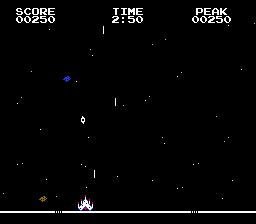
The way it works is like this. Rocks, Pulsars and Spinners fall from the sky, and your ship tries to shoot them before they hit the ground. You get points for shooting things, but lose points for things that get past you. Rocks come in two sizes (smaller ones have higher point values), but only kill you if they hit you. Big rocks break apart into small rocks when stuck. Pulsars home in on you as they fall, which makes it more likely they’ll hit you, but also means they’re easier to shoot. The most dangerous items plummeting towards you though, by far, are the Spinners. You must shoot Spinners, you don’t just lose points if one lands but a life. Small Spinners are your greatest enemy, since they’re also hard to hit. There’s also UFOs that harass you, which pass by horizontally and drop bombs on you.
Here is a short game of Astroblast, to give you a sense of how it works. Notice how fast it is. Know that this is nowhere near as fast as it gets. It is my kind of game:
As you score gets higher, the background color changes, and the game gets faster. You get extra lives every 1,000 points, and you start with ten, far more generous than most arcade-style skill tests from that time, but you need all those lives because you’re constantly dying. Difficulty is determined by score, the more points you have the faster it gets. Because you lose points as well as gain them, and because the speed is balanced right at the edge of human reaction time, players tend to play until they reach a difficulty score boundary, where only nearly-inhuman focus, and lots of practice, can push you beyond it. Astroblast will push your playing skills to the very limits.
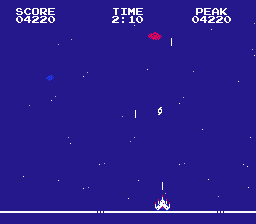
Astro Smash ‘N’ Blast is an homage to these two games. It takes the same form, your ship at the bottom shoots upwards at an endless wave of plummeting targets, Rocks, Pulsars and Spinners. (There are no UFOs in this version.) There’s fewer things falling, but the game is a bit more precise about hitting small targets. Pressing the Select button turns on autofire, which you’ll probably want to use, to avoid compressing your thumb tissue into a singularity with rapid frantic tapping.
Rocks don’t split in two in this version, but otherwise it plays a lot like VCS Astroblast. Small Spinners are particularly difficult targets to hit, and must be aimed at precisely.
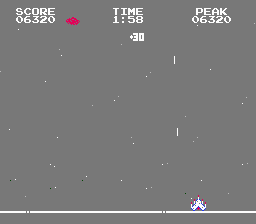
This version takes on a bit of inspiration from Pac-Man CE, in that in addition to having limited lives, you have a time limit. You can earn extra time by hitting +30 second targets that pass by horizontally, and you can regain hits on your ship by hitting passing 1UPs. These are the only bonuses; unlike the originals, you don’t get extra ships from points at all. Although the game ends if you run out of time, chances are great that you’re going to lose all five of your lives before then.
As in Astrosmash/blast, as you ascend to tougher difficulties, the screen’s background color changes. You probably won’t see the later levels though without a lot of practice. Astro Smash ‘N’ Blast offers a level of challenge rarely seen in most games. I prefer games like this, with a strong element of chaos, to more typical modern examples of high challenge, like bullet hell shooters and rhythm games. I think the essence of the super fast video game is in randomness, not memorizing levels and playing them almost by rote but in reacting instantly to dynamic situations, and that’s why I like all the Astro-style games.
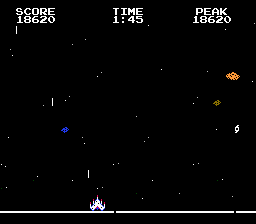
I am left wondering what inspired Double Z to look to old Intellivision and Atari games for inspiration. They were released when I was a small child; had Double Z even been born yet when the Astro games were on store shelves? For whatever reason they made it, I am glad they did. Games like this don’t come around often any more, and I intend to put in some solid practice on it.
Astro Smash ‘N’ Blast, for NES (romhacking.net)
Indie Game Showcase 11/30/22
The weekly indie showcase spotlights the many indie games we play here on the channel. If you would like to submit a game for a future stream and video, please reach out.
- 0:00 Pogo Champ
- 2:10 Grapple Dog
- 4:16 Peppy’s Adventure
- 6:25 Elven Warmaiden
- 10:00 Strange Horticulture
- 11:56 Deflector

Owner of Game Wisdom with more than a decade of experience writing and talking about game design and the industry. I’m also the author of the “Game Design Deep Dive” series and “20 Essential Games to Study”
A Retro-Focused Guide for Dance Dance Revolution Beginners
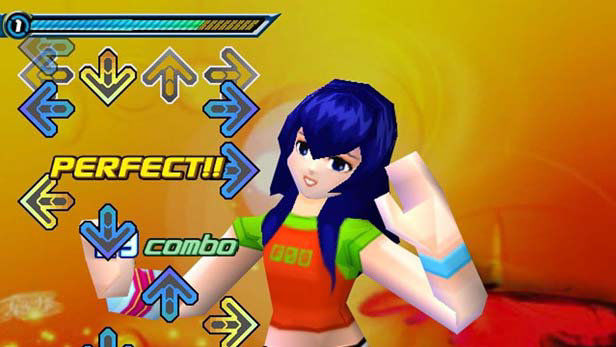
Racketboy has a great article about getting started with Dance Dance Revolution at home. DDR is still kind of going in U.S. gameplaces from the 2016 release of “Dance Dance Revolution A,” but hasn’t received a home release in that country since the days of the Wii, in 2011. That leaves options to picking up a home machine, finding a version for an older console, or, of course, yarr. Thanks, Konami! Your attention to preventing access to your products is ridiculous and easily mocked!
The ultimate decision reached is to play DDR Max or Extreme 2 on a Playstation 2, and on a CRT if at all possible, but the article contains a number of options that may be more workable for you. Dance on!
DDR Beginners Home Guide for Retro Gamers
More Info on the Return of Blaseball
As reported earlier, Blaseball is coming back. Over the past couple of months the site has been playing host to “Fall Ball,” where players from past eras of Blaseball have been falling out of a Black Hole onto the 24 teams.
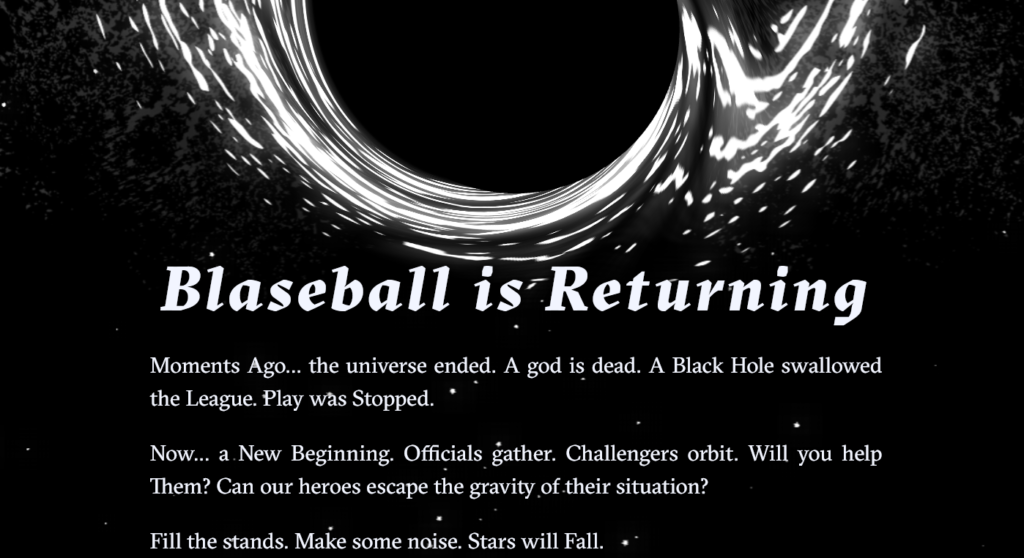
More information has been scarce. Fact Alpha about Blaseball is that information is always scarce. But they did post a FAQ on the site with information on what is happening, and what is to come. (If you are still clueless about this whole Blaseball thing, see after the list.) Basically:
- The players falling out of the Black Hole are the simulation seeding the teams for the next season. We don’t know if this is just drawing lots or if some underlying process is at work.
- This is the form of the “Pre-Season” for the next era. It’ll end on December 30th, and some time after that games will resume.
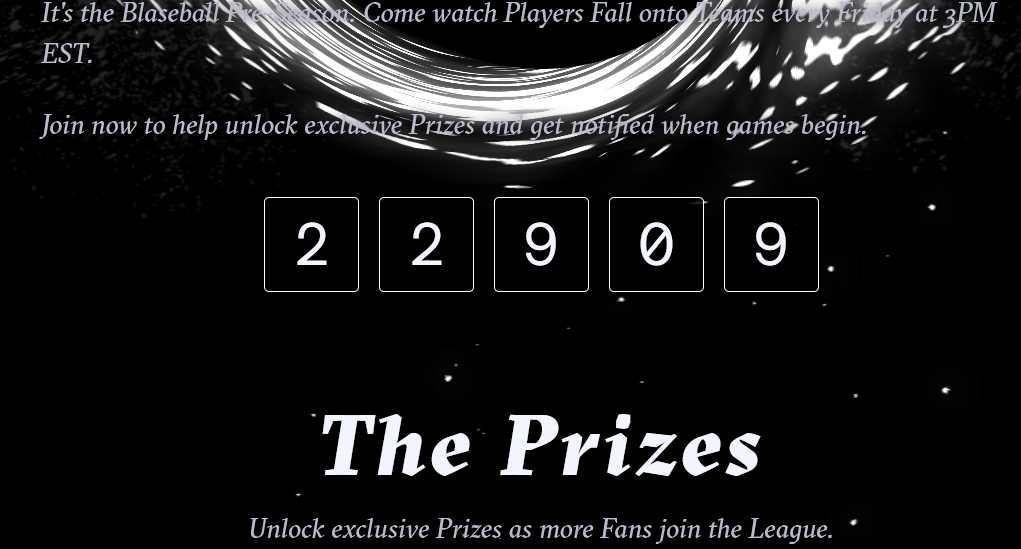
- Blaseball’s return won’t just be on the web, there will be iOS and Android apps!
- The number on the site is the number of fans (human being persons) who have signed up to keep up with news on Blaseball’s return. As more fans sign up, more information about the season, and the weird universe of Blaseball, will be revealed. As of this writing the next reveal is slated to happen at 30,000 fans, which is some ways away with just a month to go. Even fans who had been active before should still sign up, they say. It’s kind of like a RSVP.
- “Prizes” given out as the number of signups increase include special social features and commemorative pins.
- The FAQ recognizes that Blaseball had gotten a bit involved at the end of the previous season (its words are that it “contains multitudes”) and the new format is meant to make it more accessible to new (and lapsed) fans.
So, what is Blaseball? It was a weird sports simulation that went viral in 2020 at the height of COVID pandemic social distancing. “Players” of Blaseball are not the humans who follow the game. Instead, they’re wholly virtual entities. In fact, games of Blaseball, for now at least, have no visual component beyond a text ticker and a diagram showing which bases are occupied.
A Blaseball season is roughly one week (or, towards the end of the previous era, two weeks). Games advance at the rate of one event every couple of seconds or so. Blaseball players possess a whimsical assortment of stats in a variety of ways, some more obvious than others, with names like “buoyancy,” “patheticism,” “Shakespearianism,” and a player’s “soulscream,” which is a string of random-like characters.
What Blaseball is, essentially, is a sport for people who don’t like sports. (Blaseball calls itself a “splort.”) Blaseball players aren’t millionaires, and won’t express odious political opinions, and Blaseball teams won’t stubbornly stick to offensive stereotypes for their team name and logo. Yet Blaseball doesn’t lack for its own form of drama. Ordinary baseball players may get injured, but Blaseball players can be outright incinerated by rogue empires during solar eclipses. And, while fans (Blaseball’s name for human participants like me and, perhaps, you) cannot directly affect games, they can indirectly influence outcomes by voting on advantages for their teams, and can bet fake money (but not paid-for perks or NFTs!) on outcomes.
Blaseball developed a huge and absurd fandom during its early months which, truthfully, it seems to have been trying to recapture in the time since. There is a website player statistics, blaseball-reference.com. There’s both an unofficial and official channel giving seasonal recaps. There’s even an internet-famous band, the Seattle Garages, named after the Blaseball team, and songs like Mike Townsand Is A Disappointment.
Blaseball may never again become as popular as it was during quarantine times, but it is a unique internet thing and I personally eagerly await its return.
That official YouTube channel is pretty humorous, by the way, and you might be interested in a couple of videos from it. Here’s one recapping its earliest seasons:
All of those videos are very entertaining! And quite confusing!
Blaseball – Blaseball FAQ – Blaseball’s YouTube Channel – The Blaseball Roundup – Blaseball Blexplained
Haiku the Robot Developer Interview
An interview with Jordon Morris who designed the metroidvania Haiku the Robot for a chat about the game and metroidvania design. We spoke about the creation of Haiku, how the environments were designed and balanced, and more about making a metroidvania.

Owner of Game Wisdom with more than a decade of experience writing and talking about game design and the industry. I’m also the author of the “Game Design Deep Dive” series and “20 Essential Games to Study”
The Castlevania Dungeon
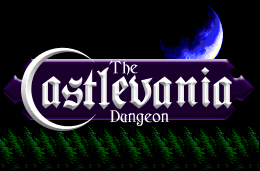
I love finding something on the internet that still exists after decades, and one such site is Kurt Kalata’s The Castlevania Dungeon (“This site uses HTML and CSS”) which, surprisingly, updated again last year, nine years after its previous update. Although, it was mostly a catch-up post just to let the world know it probably wouldn’t be updating again.
Kurt has moved on to Hardcore Gaming 101 since then, which build an amazing repository of classic gaming information, tore it all down, and built it up again. Meanwhile the Dungeon continues carrying all kinds of useful information on 35 years’ worth of games.
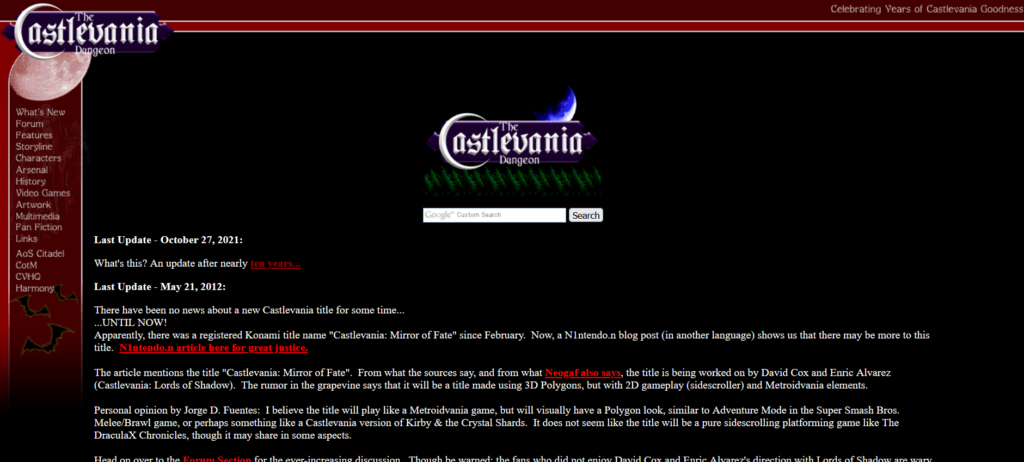
I’ve said before that I am heartsick for the era of the internet where the web was rife with sites like the Castlevania Dungeon. Yet, like that one video store here in my town that somehow survives even now, it persists, and that lifts my spirits. I know it’s too much to expect it to last forever, but I hope it does.
The Forum gives a Bad Gateway error, it is true, and of the main sites on the Links page only five of the 16 still work -one of the broken ones is the site for Konami of Japan. The internal pages other than the forum seem to work though. They lists all the games, has pages for artwork and music, and tries to untangle the storyline. It has a collection of fan fiction. It even hosts a few shrines to individual games, with an entertainingly lo-fi shrine to Aria of Sorrow.
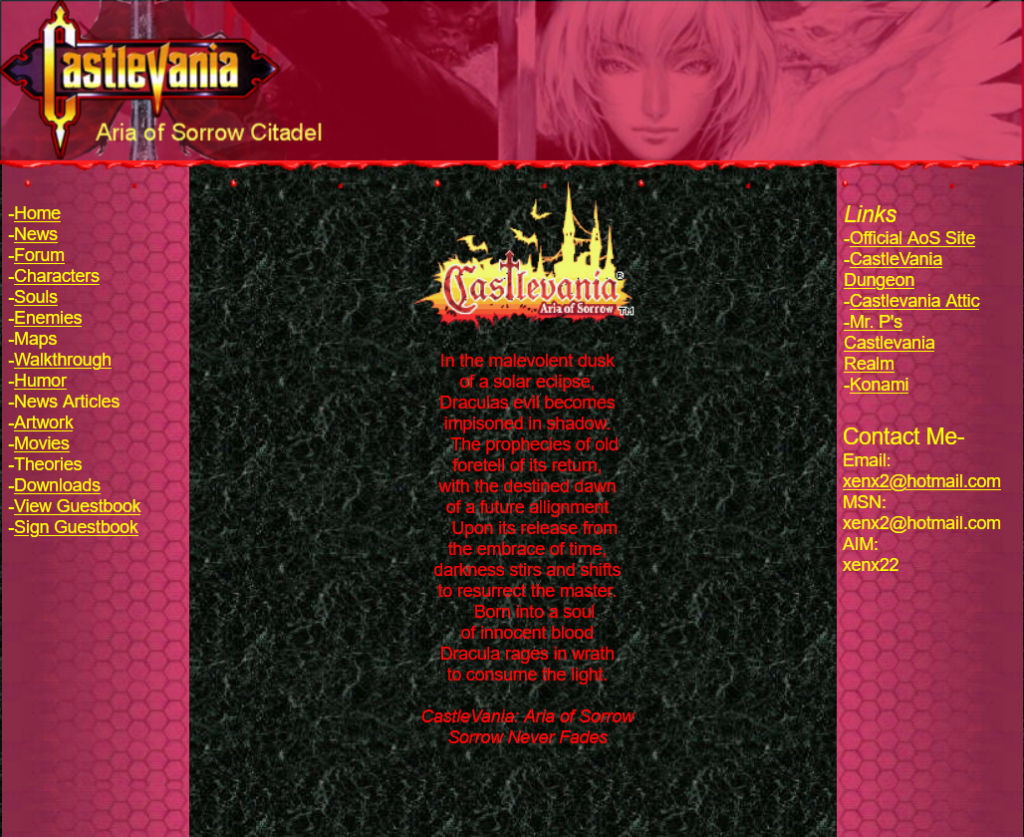
This is what the web was about, in the early days, and, I think, it’s still among what it’s best at.

